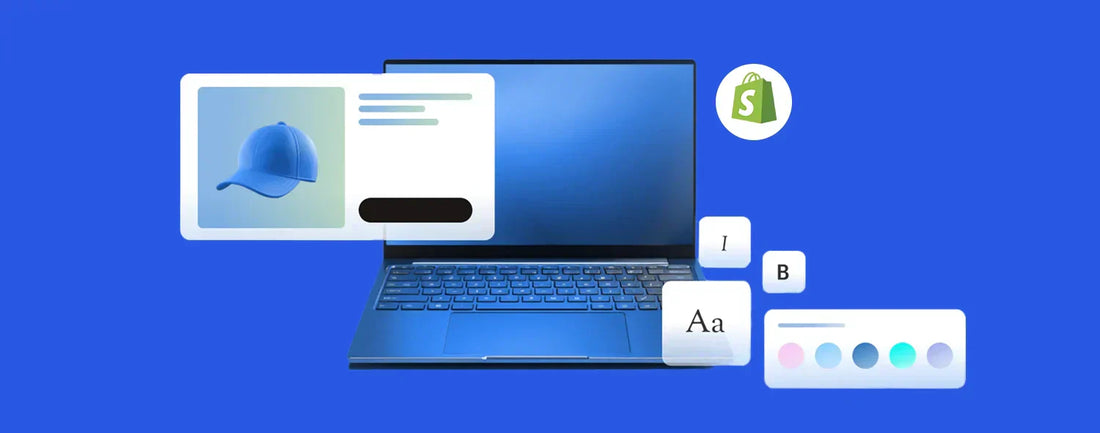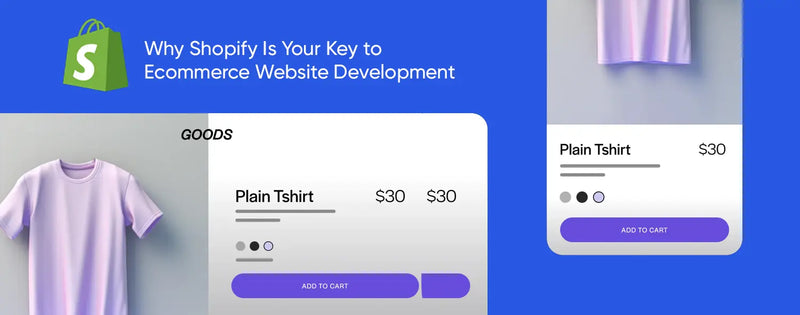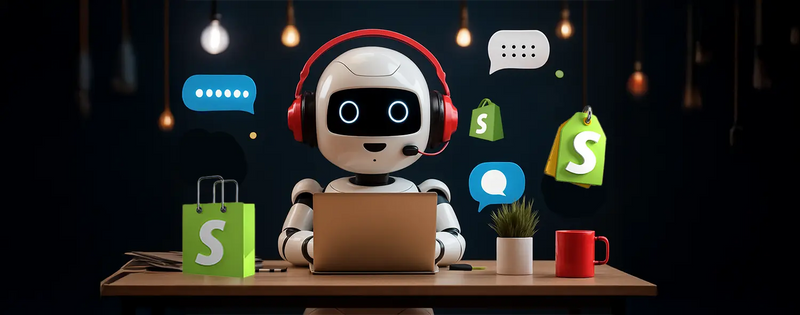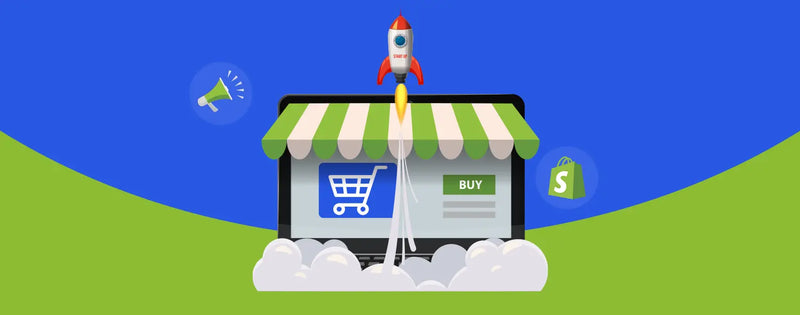Table of Contents
The right tips for designing your Shopify website can define your brand, bringing in customers and value to your store. Within a few seconds, the visitors make their choices on whether to look around or not. That decision will be the difference between a successful business and lost chances in 2025, as global eCommerce sales are predicted to reach more than $8.1 trillion.
To create a high-performing Shopify website, the need to only look good is long gone, but instead it is time to create an experience that is not only smooth, user-friendly, and memorable but will leave visitors loyal customers. Be it mobile-friendly layouts and blistering fast loading speed or smart customization and effortless call-to-actions, all the design choices affect the way customers feel and use your brand.
This guide provides 10 key tips for designing your Shopify website in 2025. It will assist business owners to differentiate their brand, stimulate sales, and put their business on the road to long-term development.
Key Tips for Designing Your Store
1. Prioritize Digital Accessibility for Inclusive Reach
 Digital accessibility makes your Shopify website accessible to all, such as people with disabilities, who constitute about 1.3 billion people all over the world (World Health Organization, 2025). Inaccessibility will send away potential customers and lead to legal liability: 82% of all web accessibility lawsuits in the last few years have been against ecommerce websites. To business owners, emphasis on accessibility promotes the brand reputation, customer retention, and is morally right.
Digital accessibility makes your Shopify website accessible to all, such as people with disabilities, who constitute about 1.3 billion people all over the world (World Health Organization, 2025). Inaccessibility will send away potential customers and lead to legal liability: 82% of all web accessibility lawsuits in the last few years have been against ecommerce websites. To business owners, emphasis on accessibility promotes the brand reputation, customer retention, and is morally right.
Actionable Steps:
- Keyboard Navigation: Enable full site navigation without a mouse, critical for users with motor impairments.
- Alt Text: Alt text is always placed to improve the search performance and also to support the use of screen readers.
- Semantic HTML: Structured semantic markup of logical content flow can support assistive technology.
- Contrast Ratios: Ensure a 4.5:1 contrast ratio for text, verifiable via Shopify’s accessibility tools.
- Cognitive Accessibility: Reduce the cognitive load by simplifying language to a 9th-grade level of reading and not using time-based content.
More Information:
- The WebAIM Million 2025 report notes that complex e-commerce pages average 50+ accessibility errors, yet simple fixes can reduce this significantly.
- The novel trends are the use of AI to transcribe video captions and make the user more engaged by 40 percent in the case of hearing impairment.
- Also, voice navigation is essential because voice search will be half of search queries in 2025.
- Consider haptic feedback between mobile users with motor challenges, one of the inclusions of inclusive design that is gaining popularity.
- Check with the help of such a tool as WAVE or Lighthouse to ensure that it is compliant and usable, and place your brand on the frontline of ethical e-commerce.
2. Streamline Navigation for a Frictionless User Journey
Effective navigation is one of the foundational tips for designing your Shopify website, as 38% of users abandon sites with confusing layouts. Simplified navigation reduces friction, guiding customers from landing to checkout with ease, potentially increasing conversions by 30%. For businesses with large catalogs, intuitive navigation is non-negotiable to maintain engagement.
Actionable Steps:
- Clear Labels: Use descriptive menu labels like “Shop by Category” for clarity.
- Product Filters: You can use filters based on the size, color, price, or popularity to help make the shopping process easier.
- Search Optimization: Have an obvious search box with auto-suggestions that will decrease the time to search by half.
- Reduce Clicks: It is recommended to adhere to the three-click rule that requires key pages to be reachable within three clicks or fewer.
- Sticky Headers: Have CTAs such as Add to Cart available, particularly on mobile.
More Information:
- Predictive navigation with the help of AI, as in the Search and Discovery app of Shopify, customizes the user experience according to their behavior to cut the time of the session by 20%.
- Breadcrumb navigation enhances the SEO and user orientation, and a process split into many steps performed with gamified elements, e.g., progress bars, can increase the number of completions by 15% (A/B testing data).
- You can test heatmaps (e.g., Hotjar) to identify and eliminate areas of friction, ensuring a seamless experience and conversions.
3. Use Quality Visuals to Tell Great Stories
 The quality of images and videos is central to ecommerce, and professional visuals have been shown to increase the conversion rates by 20-30 percent. Visuals help in the evaluation of products, particularly in online shopping. Implementing this among other tips for your Shopify website is of utmost importance because videos and product demos can increase purchases by 85%.
The quality of images and videos is central to ecommerce, and professional visuals have been shown to increase the conversion rates by 20-30 percent. Visuals help in the evaluation of products, particularly in online shopping. Implementing this among other tips for your Shopify website is of utmost importance because videos and product demos can increase purchases by 85%.
Actionable Steps:
- Multi-angle Shots: Use multi-angle shots or lifestyle shots to display products.
- Video Integration: Host shoppable videos to feature and motivate impulse purchases.
- Optimization: Use compression tools such as TinyPNG so that the speed is not lost.
- Alt Text: Add descriptive alt text for SEO and accessibility.
More Information:
- Enhancing imagery with the help of AI like automatically generated product variations simplifies the content development process but also increases engagement.
- AR try-ons, commonly used in the beauty and fashion industries, are about to cut returns by 35 percent.
- User Generated Content (UGC) will promote authenticity and persuade people to submit their videos through post-purchase emails.
- By 2025, the short-form videos that take the shape of TikTok will be the most popular and will force people to make purchases, especially when placed on the product pages.
- Ensure lazy loading so as to achieve a balance between visual richness and performance by ensuring that it is compelling to the narrative, turning browsers into buyers.
4. Master Typography for Brand Consistency and Readability
 Typography influences the brand and user experience, and low readability can add 20% to bouncing. The collection of essential tips for designing your Shopify website will be incomplete because readable typography strengthens your brand, and makes it easy to use across devices.
Typography influences the brand and user experience, and low readability can add 20% to bouncing. The collection of essential tips for designing your Shopify website will be incomplete because readable typography strengthens your brand, and makes it easy to use across devices.
Next Steps:
- Font Selection: We recommend 2-3 fonts, such as Sans-Serif for body content (minimum of 16px) and a bold font for the headline.
- Consistency: Having the same font on each platform creates brand familiarity and recognition.
- Hierarchy: The fonts selected and weights of the fonts used are representing a structured order of content logically to the user.
- Contrast: It is best practice to utilize high-contrast colors when pairing fonts together to boost accessibility.
More Information:
- Variable fonts, dynamic fonts, are 30% smaller in load and responsive in nature.
- Slight animations added to kinetic typography improve the experience and grow dwell time by 25 percent (UX studies).
- In the case of global brands, multilingual font support is crucial because three-fourths of customers prefer native-language web pages.
- Use programs such as Readable.io to make the tests legible.
- As opposed to the popular belief, do not use overused decorative fonts, but instead, use minimalist modern options such as Numod to fit the minimalistic trend of 2025 because the typography should tell the story of your brand.
5. Select a Strategic Color Palette to Impact Buyer Behavior
Color has a powerful impact on buying behavior, affecting 85 percent of buying choices (Color Marketing Group), and the colors you use can be a potent instrument of persuasion and emotion. Soft neutrals that are bold CTA accented rule the day in 2025 with a perfect blend of calm and crisis.
Key Steps:
- Brand Alignment: Choose colors that evoke the emotional response you want to project for your brand, e.g., blues will make someone feel trustworthy, reds will make someone feel they're in a hurry.
- Contrast: Make sure text-background contrast is accessible.
- Limited Palette: Keep only 3-4 colors to remain consistent.
- Testing: Schemes can also be tested and experimented with tools like Adobe Color.
More Information:
- Preferred by 82% of our users, dark mode helps reduce eye strain and is more sustainable in terms of design as it reduces the amount of energy consumed by the screen.
- Gradients are optional and need to be made fast.
- Sustainability focused brands use earthy colors, which appeals to three-quarters of consumers who care about green behavior.
- Small details can increase conversions by 10% A/B testing color schemes can generate big effects on small changes.
- Your color scheme needs to appeal to customers on an emotional level which builds trust and encourages action.
6. Go Mobile First To Shopping
 It needs to be mobile-first since mobile ecommerce will provide 75% of the sales in 2025 (Statista). Smaller screens allow user experience and search ranking to be designed first, which is crucial for scaling to desktops.
It needs to be mobile-first since mobile ecommerce will provide 75% of the sales in 2025 (Statista). Smaller screens allow user experience and search ranking to be designed first, which is crucial for scaling to desktops.
Next Steps:
- Responsiveness: Use Shopify themes responsive to any screen.
- User Friendly: Big, tappable buttons and minimal menus.
- Speed Optimization: Optimise 3G networks, one half of the users access 3G slower.
- Testing: Interoperability Testing by device testing.
More Information:
- Progressive web apps (PWAs) via Shopify apps transform sites into app-like experiences, boosting retention by 137%.
- Mobile search optimization of voice (which is now half of all queries) needs conversational content design.
- Checkouts such as Apple Pay that operate on a single tap cut abandonment by 20 percent.
- Do not follow the conventions, but focus on micro-interactions (e.g., animated buttons) to make your mobile experience more interactive, without being busy.
- Some brands such as Coregami display smooth mobile-desktop transitions, making sure that no single customer is left out.
7. Apply Personalization to Improve Customer Engagement
Personalization leads to 20 percent higher sales due to the fact that it makes shoppers feel valued (McKinsey, 2025). Shopify applications provide personalized recommendations of what to purchase based on their interaction or past purchases or location, helping create stronger bonds.
Next Key Steps:
- Dynamic Content: Shopify Search and Discovery are apps that give personalized product recommendations.
- Targeted Promotions: Provide place-based offers or behavioral-based emails.
- Ethical Data Use: Explicitly share data practices in order to establish trust.
More Information:
- AI-enhanced personalization, estimated to contribute to e-commerce a sum of 2.95 trillion by 2030, optimizes suggestions on a real-time basis.
- Geo-personalization modifies content according to region with more relevance.
- Zero-party data through preference form or quizzes is trust-building, and it will solve privacy issues to 81% of customers.
- Gamified rewards can enhance retention by a quarter as opposed to common tips, but only when personalized loyalty programs are implemented.
- Personalization will change your site into a personal virtual shopper, which encourages repeat purchases.
8. Optimize Load Speed for Performance & Retention
 The reason behind optimization of speed is that a 1 seconds delay during the load time reduces conversions by 7 percent (Google). Slow websites are a disadvantage to SEO rankings as Core Web Vitals is a priority of Google.
The reason behind optimization of speed is that a 1 seconds delay during the load time reduces conversions by 7 percent (Google). Slow websites are a disadvantage to SEO rankings as Core Web Vitals is a priority of Google.
Actionable Steps:
- Reduce Apps: Bundling: Minimize your code bloat through consolidation.
- CDN Usage: Leverage content delivery networks for global performance.
- Check-ins: Halfway with Google PageSpeed Insights, with a goal of 90+.
2025 Trends:
- Headless Shopify: Using server-side rendering, halves load times, enhancing user experience.
- Sustainability angle: Faster sites reduce carbon emissions, aligning with ICT’s growing environmental impact (projected to surpass most countries by 2030).
- Lazy loading and caching are standard but underutilized, you can implement them for instant gains.
- Speed isn’t just technical; it’s a competitive edge that keeps customers engaged.
9. Select the Right Shopify Theme for Scalability and Aesthetics
Your theme sets the foundation for design and functionality. Choose based on catalog size, brand aesthetics, and mobile responsiveness. Opt for free themes like Dawn suit startups, while paid options like Turbo handle large inventories.
Actionable Steps:
- Industry Fit: Filter themes by industry in Shopify’s Theme Store.
- Customization: Opt for themes with flexible options via builders like Instant.
- Performance: Make sure to maintain mobile responsiveness and quick load speeds.
2025 Trends:
- Schema markup-supported themes enable rich snippets, boosting click-through rates by 30%.
- No-code builder-based hybrid themes scale with AI-based features, providing future-proof scalability.
- Diverge from regular recommendations and focus on themes that come with analytics dashboards for immediate feedback.
- A/B test themes so that your performance is optimized, ensuring consistency with your brand's long-term strategy.
10. Establish Trust through Social Proof and Sophisticated Integrations

A research by Nielsen reveals that 92% of buying decisions are driven by social proof, hence it highlights the importance of reviews, UGC, and testimonials. Apps like Stamped.io simplify integration of real-time purchase notifications to create urgency.
Actionable Steps:
- Reviews and UGC: Display customer reviews and photos prominently.
- Testimonials: Use video testimonials for an 80% conversion lift.
- Trust Badges: Add security seals to reassure buyers.
2025 Trends
- AI-moderated reviews ensure authenticity, addressing fake review concerns.
- VR/AR previews, like virtual try-ons, enhance trust in high-value niches.
- Integrating with Instagram feeds or marketplaces via the omnichannel increases loyalty by 15%.
- Privacy badges are examples of GDPR-compliant trust signals and are essential because 64% of consumers value data security (PwC, 2025).
- Social evidence can turn sceptics into brand-loyal customers, increasing the credibility of your brand.
10 Shopify Store Examples with Exceptional Design (2025)
1. De La Calle
Unusual typography and lively brand color use; quality product shots and concise homepage text describing the sources and ingredients of the drink.
2. Duradry
Uncluttered and simple design, which highlights the modern nature of the brand.
3. Snacklins
Playful and engaging visual design, blending bright visuals with easy navigation to elevate snack branding. Included among Shopify’s showcase of beautiful websites.
4. Magic Spoon
Retro-modern style with vibrant colors and nostalgic branding, wrapped in clean layouts, is another Shopify-highlighted design.
5. Great Jones
Elegant product displays combined with sophisticated typography and high-end imagery; featured in Shopify’s curated list of inspiring designs.
6. Silk & Willow
Ethereal and refined, this wedding décor boutique site uses soft tones and beautiful detail photography to reflect its sustainable craftsmanship.
7. Gymshark
Dynamic fitness apparel store with seamless navigation, bold visuals, and brand consistency. Design excellence paired with high performance and fast, responsive layouts.
8. Fenty Beauty
Stylish and brand-forward, with chic imagery, refined layout, and consistent aesthetic that supports brand identity.
9. Pela
Green accessories brand Pela's design combines understated sophistication with mission-based storytelling to create a clean and values-focused visual experience.
10. Huel
Contemporary utilitarian design with a focus on clarity and usability. Simple product presentation, phone-friendly interface, and clear branding that appeals to busy consumers.
Why These Examples Shine in 2025?
Across the board, these exemplary Shopify stores share several standout design traits:
- Cohesive Branding: Each outlet is visually consistent with its careful application of color, typography, imagery, and tone.
- User-Focused Layouts: Clean, intuitive navigational structures and minimalist aesthetics support seamless user journeys.
- Stunning Designs: Retro, elegant, or vibrant, each of these brands uses strong photography and design to connect with visitors immediately.
- Quick & Mobile-First Design: Fast, responsive designs that are mobile-friendly will continue to be a feature of the best stores of 2025.
Let’s Arrange A Shopify Store To Aid Your Business!
Your Shopify shop should be more than just a website, it should be a sales machine, one that attracts, engages, and grows. At ShopX, we come to your business with a creative, performance-driven conception of how to design your Shopify store. Our designers emphasize the creation of a visually beautiful, mobile-friendly, and conversion-optimized storefront that reflects your brand identity. Whether it be your shop layout, product pages, collection pages, or checkout process, we are meticulous in the details so as to create an enjoyable shopping experience for your customers.
We produce boutique designs that are rooted in effective eCommerce strategies to not only bring visitors to your store, but also convert them into loyal customers.
Are you ready to elevate your brand?








